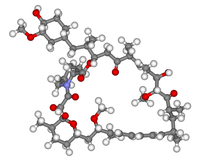
Photo from wikipedia
Abstract Background Glioblastoma (GB) are brain tumors with a poor prognosis despite multimodal treatment combining resection, chemotherapy (CT) and radiotherapy (RT). The rich vascularization of these tumors led to the… Click to show full abstract
Abstract Background Glioblastoma (GB) are brain tumors with a poor prognosis despite multimodal treatment combining resection, chemotherapy (CT) and radiotherapy (RT). The rich vascularization of these tumors led to the introduction of anti-angiogenic therapy with most efforts focused on the vascular endothelial growth factor (VEGF). However, the angiopoietins (Ang) have emerged as alternative regulators of angiogenesis. In particular, in GB, Ang2 is up-regulated and stimulates tumor angiogenesis in concert with VEGF but also activates pro-angiogenic functions of macrophages. However, Ang2 functions are context-dependent. Therefore, we sought to elucidate the involvement of Ang2 in the interaction of glioma response to CT and RT, both therapeutic modalities known to alter tumor angiogenesis and inflammation. Methods To recapitulate high levels of Ang2 in GB patients, Ang2 was overexpressed in murine glioma cells (GL261-Ang2). Effects of Ang2 were studied on an orthotopic syngenic model of GB (GL261 cells) in response to combined CT/RT. C57bl/6 mice were co-treated with temozolomide (TMZ 10 mg/kg; i.p.) and brain tumors were irradiated with X-rays (4 Gy) at 7, 9 and 11 days post-cell injection. The tumor growth and its microenvironment were followed by MRI and immunohistology analyses. Results We showed that, in this model, the chronic overexpression of Ang2 does not modify tumor progression, but leads to a decrease in vessel density (-39±10%, p 3 months) compared with treated GL261 tumors (18±3 days). In vitro, no difference in the chemo-radiosensitivity of GL261 and GL261-Ang2 cells was noticed, suggesting a paracrine effect of Ang2 on the tumor microenvironment. Accordingly, we showed that Ang2 sensitizes the tumor vasculature to CT/RT and sustains inflammatory cells in the tumor microenvironment until 3 months post-treatment. Conclusions These results suggest that Ang2 might influence the therapeutic response of GB by acting on angiogenesis and inflammation. Legal entity responsible for the study E. Petit. Funding This study was funded by the Region Normandie, the Centre National de la Recherche Scientifique (CNRS), the Universite de Caen Normandie (UNICAEN), the European Union-Fonds Europeen de Developpement Regional (FEDER), ARCHADE, HABIONOR European project, la Federation pour la Recherche sur le Cerveau par l’operation Rotary «Espoir en tete » (FRC), EdNBise 497 - Normandie Universite. Disclosure All authors have declared no conflicts of interest.
Journal Title: Annals of Oncology
Year Published: 2019
Link to full text (if available)
Share on Social Media: Sign Up to like & get
recommendations!